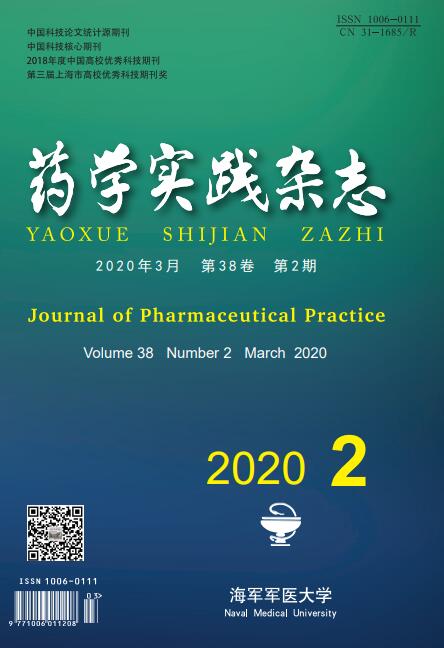-
慢性乙型肝炎(chronic hepatitis B,CHB)是乙型肝炎病毒(hepatitis B virus,HBV)慢性感染所导致的疾病,具有反复性、长期性等特点,可造成肝硬化、肝癌等严重肝脏疾病甚至导致患者死亡[1]。根据慢性乙型肝炎临床症状和体征,中医辨证可将其归属于“黄疸”、“胁痛”、“肝着”、“肝瘟”、“湿阻”、“疫疠”等范畴[2]。中医药治疗CHB可依据中医的症状,以中医宏观调控理论为主,并参照西医检查肝功能、病理学检查、病毒定量等手段进行辨证论治。此外,中医的免疫调节作用还可能使纯中药或中西医结合治疗成为降低核苷(酸)类似物停药复发率的一种选择[3]。本研究通过观察中医辨证联合恩替卡韦后治疗CHB的临床疗效,比较两种治疗方案的优劣,为临床使用提供依据。
HTML
-
选取2017年10月至2018年9月上海健康医学院附属嘉定区中心医院中医肝病门诊就诊的CHB患者80例作为研究对象。选择标准:符合CHB的临床诊断标准,符合我国《慢性乙型肝炎防治指南(2015年版)》中相关诊断标准及首次抗病毒条件[4],且均乙型肝炎E抗原阳性、乙型肝炎E抗体阴性。排除标准:肝细胞癌或失代偿性肝病者,重叠或合并其他肝炎病毒感染者,对核苷、核苷类似物高度过敏者,合并心脏等脏器严重疾病者,6个月内接受过抗病毒、免疫抑制剂治疗者。将入选的80例CHB患者按随机数字表法分为两组。观察组依据中医辨证分型施药加恩替卡韦治疗,患者40例,男27例,女13例,年龄在16~60岁之间,平均40岁。对照组以恩替卡韦治疗,患者40例,男25例,女15例,年龄17~58岁之间,平均38岁。观察组与对照组在年龄、性别、病程以及辨证分型等方面比较,无显著差异(P>0.05),具有一定可比性,见表1。
组别 例数 肝气郁结 肝郁脾虚 气滞血阻 肝肾阴虚 湿热阻滞 对照组 40 11(30) 8(20) 5(10) 9(23) 7(17) 观察组 40 12(33) 9(23) 6(13) 7(17) 6(13) -
对照组给予西医常规治疗,选用恩替卡韦片(南京正大天晴药业公司)1 mg qd po。观察组加用中药治疗,草药汤剂由本院中药房提供。中医治疗根据“慢性乙型肝炎中医辨证规范和疗效评价体系[5]”辨证分型为5种:肝气郁结证、肝郁脾虚证、气滞血阻证、肝肾阴虚证、湿热阻滞证。肝气郁结以柴胡舒肝散(柴胡10 g、白芍10 g、枳壳10 g、炙甘草3 g、川芎10 g、香附12 g)为主方;肝郁脾虚以逍遥散(柴胡9 g、薄荷3 g、党参15 g、茯苓12 g、白芍10 g、白术12 g、炙甘草3 g、当归12 g、生姜3片)为主方;气滞血阻以大七气汤加减(三棱10 g、莪术10 g、青皮9 g、陈皮12 g、木香5 g、炙甘草3 g、藿香10 g、益智仁9 g、桔梗6 g、肉桂3 g、生谷麦芽各30 g)为主方。肝肾阴虚以一贯煎(北沙参12 g、麦冬9 g、当归9 g、生地黄12 g、枸杞子12 g、川楝子6 g)为主方;湿热阻滞以茵陈四苓汤(茵陈15 g、郁金12 g、金钱草15 g、茯苓12 g、猪苓12 g、泽泻12 g、白术12 g、陈皮12 g、枳壳10 g、焦三仙12 g、甘草3 g)为主方。肝病门诊患者每2周复诊一次,临床根据症状,食积加神曲、麦芽、山楂、砂仁等药;化瘀加三棱、莪术、桃仁、红花、川芎、当归、鳖甲等药;行气者多用青皮、陈皮、厚朴、木香、香附等药;化痰者多用半夏、白芥子、莱菔子等药;温阳散寒者多用肉桂、干姜、良姜、茴香、丁香等药;养阴益精、清化燥热、软坚散结者多用生地、白芍、乌梅,以及黄连、大黄等药。用法:每日一剂,煎服2次。24周为1个疗程,为期2个疗程。治疗48周后,观察患者的临床症状,肝功能指标、血清学转换及乙肝病毒基因的改善程度。
-
ALT检测采用速率法,正常值范围0~64 U/L。HBV-DNA定量采用实时荧光免疫聚合酶链式反应(PCR)法测定,其最低检测值为1000 IU/ml,低于其检测值可视为转阴。e抗原及e抗体检测采用酶联免疫吸附法,检测试剂由广州达安基因有限公司提供。
-
实验室指标:肝功能、肾功能、血常规、淀粉酶、心电图。每月复查一次实验室指标。不良反应:头痛、疲劳(原有乏力者无明显加重)、眩晕、恶心。每半个月门诊随访或就诊时详细记录。
-
采用SPSS 13.0软件进行数据统计,计数资料采用χ2检验,计量资料用(
$\bar x \pm s$ )表示,采用独立样本t检验,以P<0.05为差异具有统计学意义。
1.1. 一般资料
1.2. 治疗方案
1.3. 检测方法
1.4. 安全性观察指标
1.5. 统计学处理
-
观察组与对照组相比,治疗前后患者出现的腹胀、胁痛、纳差、乏力情况的例数均有所减少,差异具有统计学意义(P<0.05),结果见表2。
组别 腹胀 胁痛 乏力 纳差 治疗前 治疗后 治疗前 治疗后 治疗前 治疗后 治疗前 治疗后 对照组 32 (80) 12 (30) 20 (50) 11 (28) 21 (53) 10 (25) 20 (50) 8 (20) 观察组 36 (90) 2 (5) * 24 (60) 2 (5) * 32 (80) 3 (7.5) * 24 (60) 0 (0) * *P<0.05,与对照组治疗后比较 -
观察组的ALT复常率较对照组有显著优势。治疗12周,观察组的复常率为33例,对照组为22例;治疗24周,观察组的复常率为38例,对照组为32例;差异具有统计学意义(P<0.05)。治疗48周,两组的复常率均为40例。结果见表3。
组别 治疗12周 治疗24周 治疗48周 对照组 22(55) 32(80) 40(100) 观察组 33(82.5)* 38(95)* 40(100) *P<0.05,与对照组治疗后比较 -
观察组和对照组经治疗24周以及48周后,患者血清学转换及HBV-DNA阴转无统计学意义(P>0.05),但是24周观察组HBeAg转阴率以及24周血清学转换分别达30%、27.5%,48周观察组HBeAg转阴率以及24周血清学转换分别达35%、32.5%,表明观察组有一定治疗效果。结果见表4。
组别 HbeAg下降> 1log HBeAg转阴率 血清学转换 HBV-DNA转阴率 12周 24周 48周 24周 48周 24周 48周 对照组 6 (15) 9 (22.5) 11 (27.5) 9 (22.5) 10 (25) 35 (87.5) 38 (95) 观察组 8 (20) 12 (30) 14 (35) 11 (27.5) 13 (32.5) 36 (90) 39 (97.5) -
观察组中出现1例患者肝功能ALT一过性轻度增高(未作特殊处理),发生率为2.5%。对照组中出现1例患者肾功能异常,表现为一过性肌酐轻度增高(未作特殊处理),1例患者出现恶心,发生率为5%。均未明确与药物有关。提示恩替卡韦联合中药治疗CHB副作用较少,且两组不良反应发生率间差异无统计学意义(P>0.05)。
2.1. 临床症状比较
2.2. ALT复常率比较
2.3. 血清学转换及乙肝病毒基因比较
2.4. 安全性评价
-
《慢性乙型肝炎防治指南(2015年版)》,首次明确定义了“临床治愈”的含义是基于停止治疗后依然稳定的病毒学应答,伴有HBsAg消失。这一目标是停药后依然获得持续免疫控制的表现。在CHB的抗病毒治疗中,获得持续性免疫学控制,即在持续性HBV-DNA阴性基础上的HBeAg血清学转换和HBsAg消失是抗病毒理想的治疗终点[6]。恩替卡韦是一种环戊酰鸟苷类似物,最初应用于疱疹病毒的治疗,后来发现其对HBV具有良好的抑制效果,能够强力阻断HBV与DNA的合成,遂将其应用于CHB的治疗中[7]。恩替卡韦能够抑制HBV的病毒活性,且可对其复制产生有效抑制,从而改善其生化学和组织学,进而达到治疗的目的[8]。而基于辨证论治使用中医药治疗CHB的本质与调节免疫功能有关,尽管不同中医药治疗方案对于CHB患者免疫系统功能的调节作用侧重点可能不同,但与《指南》关于持续免疫控制的目标有一定共识[9]。中医理论在认识免疫耐受、免疫清除等CHB病理阶段的认识有邪正盛衰关系作为其辨证论治的理论基础[10],通过中医扶正祛邪的辨证思路配合恩替卡韦,能够实现提高CHB的临床疗效,无限接近甚至达到“临床治愈”的标准。
本研究观察中,两组均符合抗病毒基线要求并均为“大三阳”,其中,中医组根据患者腹胀、胁痛、乏力、纳差等症状结合舌脉四诊合参进行理论辨证分型,共分五型,各型均拟一相应主方,临床辨证加减施治。结果显示:两组在改善临床症状腹胀、乏力、纳差、胁痛诸症有显著差异(P<0.05),在24周前ALT的复常率中西药联用组亦明显优于西药单用组,在HBeAg血清学转换方面12周下降大于1log以及24周、48周HBeAg阴转、血清学转换方面亦有一定效果。有研究[11]表明,单纯使用恩替卡韦短期治疗(48~52周)HBeAg血清学转换率21%,HBV-DNA转阴率67%,无HBsAg消失。而本研究中,24周观察组HBeAg转阴率以及24周血清学转换率分别达30%、27.5%,48周观察组HBeAg转阴率以及24周血清学转换率分别达35%、32.5%。HBeAg血清学转换率观察组和对照组差异虽无统计学意义,却可提示观察组对HBV-DNA低于检测下限的比率和血清HBeAg低于检测下限的比率以及HBeAg血清学转换率有一定的治疗意义,此结果与相关研究[12]一致,也高于21%的对照组短期疗效。辨证论治联合恩替卡韦治疗不仅提高HBV-DNA阴转率、还能较明显提高HBeAg血清学转换率、改善中医症候提高及患者生活质量,推测辨证论证中药治疗可能通过调控机体免疫状态,诱导机体免疫应答等各方面影响而达到上述效果[13]。其次,辨证论治联合恩替卡韦治疗有理想的近期疗效,但远期疗效需延长随访时间做进一步研究。因此,中医辨证在改善CHB机体免疫、提高血清学转换方面有一定临床治疗意义。当然,由于样本数较少、观察时间不长以及对于CHB的基因型尚未考虑等因素使得结论尚存不足之处,今后将不断完善总结。
总之,中医辨证分型施治具有抗病毒、调节免疫等各种作用,可调理肝、脾、胃、肾,通过“清”和“通”化湿泄浊,理气通滞。可以通过“补”和“调”益肾补脾,调气治血等方法治疗,对患者康复十分有利[3,14]。笔者认为中西医结合治疗CHB可以改善患者症状,提高其生活质量,并能平衡阴阳,调整机体免疫,而且草药源于自然,价格适中,值得临床推广研究。










 DownLoad:
DownLoad: